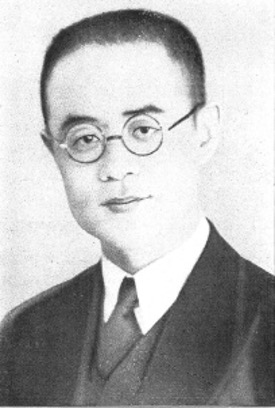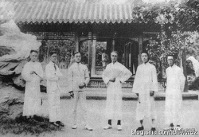Bai Dizhou
Bai Dizhouchou (May 5, 1900 - October 12, 1934) was from Beijing, born with the name Zhenying, and he is known by his courtesy name. His ancestors came from the Mongolian Baijite clan.


In 1915, Bai Dizhouchou was admitted to Beijing Normal School. He worked hard and was among the top students in every examination. After graduation, he served as the principal of the 17th Public Primary School in Beijing (now Fangjia Hutong Primary School) and the 7th Primary School (located at the southern end of Zongxue Hutong, Xidan).
In 1920, Bai Dizhouchou studied phonetics at the Mandarin Training Institute, where he was noticed by Li Jinxin, who invited him to join in the Mandarin movement. Thereafter, Bai Dizhouchou devoted his life to this cause—he was involved in teaching, discussions, promotion, inspections, and editing concerning Mandarin phonetics. The first drafts of the “Mandarin Dictionary,” which was revised by the Mandarin Unification Preparatory Committee in 1926, and the “Common Vocabulary of Mandarin,” published by the Ministry of Education in 1932, were both authored by him. Bai Dizhouchou also served as the Director of Academic Affairs at the “Mandarin Letter Training Institute” and was a major contributor to the “Mandarin Weekly.”
In 1924, Bai Dizhouchou was admitted to the preparatory program of Peking University and simultaneously supported Mr. Gu Mengyu in serving the Beijing Education Association. In 1926, he entered the English Department at Peking University for his undergraduate studies, and in 1928, he transferred to the Chinese Department, studying under Qian Xuantong, Ma Youyu, Liu Bannan, and others about phonology and phonetics. He also attended the language training program at the Institute of History and Language of the Academia Sinica, studying dialect dictation under Zhao Yuanren.
In 1928, Bai Dizhouchou became an executive member of the Mandarin Unification Preparatory Committee and the Director of the organization department at the Chinese Dictionary Compilation Office.
He graduated from the Chinese Department of Peking University in 1930 and served as the Director of Academic Affairs at the Beijing Municipal Normal School (now Capital Normal University).
From late 1932 to January 1933, Bai Dizhouchou faced immense family tragedies with the passing of his wife, three children, and father one after another.
In March 1933, Fu Sinian invited him to investigate the vowel alterations in the entering tone of dialects in Henan, Shanxi, Shaanxi, and Gansu. Bai Dizhouchou went to Shaanxi to survey dialects until mid-August. During this time, he investigated dialects in 50 locations across 42 counties in the Guanzhong area, leaving behind a wealth of survey materials. In mid-August, after returning to Beijing, Bai Dizhouchou went to Shanghai for work with the Zhonghua Book Company.
At the end of October 1933, invited by Liu Ban Nong, Bai Di Zhou entered the Department of Language and Music Rhythm Laboratory at the Peking University Research Institute as a teaching assistant.
During the summer of 1934, Bai Di Zhou accompanied Liu Ban Nong to Guizui to investigate dialects, which lasted for three weeks. After returning, Liu Ban Nong succumbed to a relapse of a returning fever, while Bai Di Zhou hurried to Chang’an to represent the National Language Society in a lecture. On September 23, Bai Di Zhou went to Zhengzhou again to attend the National Representative Conference on the Romanization of the National Language.
On October 12, 1934, Bai Di Zhou passed away at Lin Bao Luo Hospital in Beijing and was later buried in the western mountains. In fact, he contracted the returning fever during the investigation with Liu Ban Nong and died from exhaustion.
On the morning of November 11, 1934, the National Language Society held a memorial service for Bai Di Zhou, presided over by Li Jinxi, with Qian Xuantong delivering a eulogy. Friends and colleagues, including Wei Jianggong, Luo Changpei, and Lao She, published articles to commemorate him.
Bai Di Zhou’s Academic Achievements:
-
Research
-
“A Study on the Evolution of the Entering Tone in Northern Dialects,” published in the Women’s Normal University Academic Quarterly, Volume 2, Issue 2 (April 1931).
-
“A Study on Phonetic Classes in Collected Rhyme,” published in the Central Research Institute History and Language Research Institute Collection, Volume 3, Issue 2 (December 1931).
-
“Statistics on the Rhyme Units of the Guangyun,” published in the Women’s Normal University Academic Quarterly, Volume 2, Issue 1 (April 1931).
-
-
Editing
-
Draft of “Commonly Used Characters in National Sound” and “Revised National Sound Dictionary.”
-
“Guangyun Tongjian” (1931 oil-printed edition).
-
“Guangyun Entering Tone Reading Table” (1930).
-
Manuscript of “The People’s Dictionary” (compiled by the People’s Education Promotion Association in 1925).
-
-
Experiments
-
“Changes in the Entering Tone in Guanzhong,” published in the “Collection of Papers Celebrating Mr. Cai Yuanpei’s 65th Birthday” after the 1933 survey.
-
“Record of Experiments on the Four Tones,” a follow-up to Liu Ban Nong’s “Record of Four Tone Experiments,” published in the Central Research Institute History and Language Research Institute Collection, Volume 4, Issue 4.
-
Manuscript of “Guanzhong Phonology.”
-
“Standard National Sound National Language Phonograph Record,” published by Zhonghua Book Company (August 1933).
-
“A Study of Beiping Tones.”
-
“Records of Hebei Dialects.”
-
“Annotation of Homophones in Yixian.”
-
“Investigation of the Guizui Dialect.”
-
-
Articles
-
“Introducing the Vanguard of the National Language Movement—Lu Hanzhang” (National Language Weekly, Issues 10-12).
-
“A Brief Discussion on Changes in Dictionary Radicals” (National Language Weekly, Issues 10 and 19).
-
“What is ‘New National Sound’” (National Language Weekly, Issues 28-30).
-
“Examples of the Four Tones” (Issue 100 of National Language Weekly)
“The Evolution of the Entering Tone in Mandarin” (Volume 1, Issues 6 and 7 of National Language Biweekly)
“Study on the Changes of the Entering Tone in Yanggu, Shandong” (Issue 117 of National Language Weekly)
“Discussion on Qin Dialect” (Issue 98 of National Language Weekly)
“A Comparative View of Central Plains Phonology” (Beichen Academy, January 14, 1931)
- Collaborative Achievements
“Learning Zhuyin Without a Teacher” (Co-edited with Li Jinxie, before 1930)
“New Rhymes of Peiwen” (Co-edited with Li Jinxie, published by Peiwen Studio in Beiping)
“Elegance vs. Excess” (Collaborated with Tang Yue, 1925)
